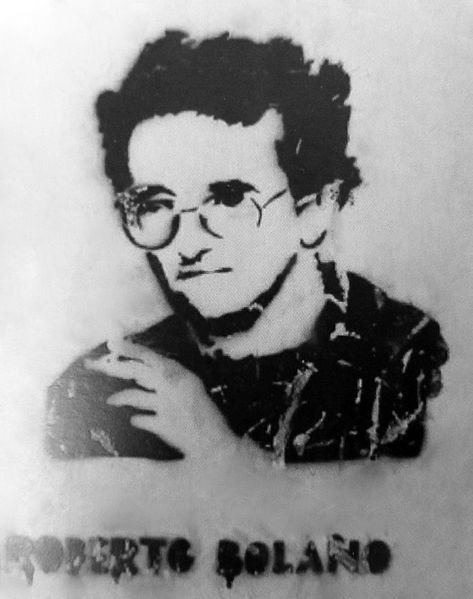A Thin Line Between Reality and Fiction. Theoretical Approach to the Author and Reader as Characters (and a Reading Recommendation).

Don Quixote goes mad from his reading of books of chivalry. Engraving by Gustave Doré. 
Dear friends,
The frontiers between reality and fiction are problematized and instead significant uncertainties appear that can be interpreted to varying degrees when the introduction of author and reader in the fictitious universe opens a fissure in the world of the text, that is, the referential universe of the work.
Estrella distante (1993) , by Roberto Bolaño, begins with a note from the author in which he clarifies for the reader the circumstances of production of the novel. The note ends with this statement: "Mi función se redujo a preparar bebidas, consultar algunos libros, y discutir, con él y con el fantasma cada día más vivo de Pierre Menard, la validez de muchos párrafos repetidos" (11). The interlocutor (él) mentioned in this note is the recipient of the work, from whose disagreement with another novel by Bolaño (La literatura nazi en América, 1996) arises the writing of Estrella distante. This addressee (narratee, as mentioned, and to some extent characterized in the text) has direct references in that earlier novel. The note signed by Bolaño, however, is addressed to real readers. On the other hand, the allusion to Pierre Menard is an intertextual indication, since it is an allusion to the story by Jorge Luis Borges, "Pierre Menard, Author of the Quixote" (here in Spanish). These elements introduce metafictional problems for the interpretation of the status of author and reader insofar as they appear immersed in the narrative universe, and this metafictional condition marks the appreciation of the totality of the work.
Transgressions of this type demonstrate the nature that has conventionally been attributed to the author and reader, insofar as they are located in perfectly delimited areas: reality for authors and readers, and fiction for the characters. In the same way, these transgressions demonstrate problems to which the Reception Theory has been applied since the sixties of the last century, when contemplating the work as a cooperative process. The activity of the author and the reader are thus conditioned by reciprocity in the task of constructing the meaning of the text. The text, for its part, is the setting for this activity, the most characteristic aspect of which is to provide opportunities for participation.
This change of perspective in analytical considerations leads to the unfolding of the work as a conglomerate of uncertainties, an unfinished product that is realized aesthetically and ideologically in the reading. In fact, concepts mentioned above as implied reader and virtual reader, among others, are, for Dietrich Rall, in En busca del texto. Teoría de la recepción literaria (1987: 5), answers that "han dado otras corrientes semióticas actuales, con planteamientos comparables y complementarios (…) que tratan de captar las características de esa instancia prevista en los textos y necesaria para darles vida".

Jorge Luis Borges, writer. Rome, 1981, by Marcello Mencarini. Source
The previous notes, valid also for the figure of the author and for the cataloguing of the text, take on special importance for the Reception Theory , in all its aspects, since they intend to investigate the functions of these elements of literary communication. Likewise, these integrating postures generate formulations that gather moments of confluence in the activity of different agents, promoting a plural approach to phenomena, a cooperative model of literary communication, as is appropriate in our case. In this sense, author and reader are not only empirical agents of this communication, but also textual strategies and hypothesis of interpretation, as Umberto Eco (Lector in fabula. La cooperación interpretativa en el texto narrativo, 1987) suggests. Textual strategies, as author and reader are prefigured in the text in the manner of instructions of different level that compose model images. Hypothesis of interpretation, insofar as the circumstances of enunciation promote intentional updating in function of textual strategies.
Estrella distante example outlined above prescribes an approach of this nature, since author and reader appear situated at the fictional level. We are not only faced with the use of an ancient license of enunciation, by the way, but also with the metafictional exposition of a problem of representation, with important analytical consequences.
I will briefly list some of them:
- First of all, making the reference in the act of reading means considering the ontological frontiers between reality and fiction. As for the characters, the limits of the narrative universe are affected when references to real beings are introduced into that universe.
- Secondly, the intrusion of references to real people in the story installs a paradox of interpretation, which cannot be resolved in a historical or biographical reading, nor in a reading of absolute fictionalization of the referent.
- Finally, author and reader installed in the horizon of the textual reference are always images, worked by distances, of the real reader and the real author. The work on these distances, in turn, marks in the text indeterminations, sometimes empty, that are the object of interpretation through inferences, which converge in the appeal of intermediate entities between the real agents and the fictional agents, respectively, Model Author and Model Reader (see Eco, Lector in fabula. La cooperación interpretativa en el texto narrativo, 1987).

Coup of September 11, 1973. Bombing of La Moneda (Presidential Palace). Chile. Source
We can consider, then, that the character can be constituted, beyond the power that is traditionally conferred on him as an actor within the story, in an operative and functional axis of representation as a fundamental component of the referential dimension of the literary space when it is instituted within the narrative, by acquiring a certain dramatic density. It is a vehicle for the perceptions of the narrative world, an informant of scenographic connections, a vehicle for the thematization of its corporal value, and a problematizing element of the ontological status of the story.
The character is a serious thing!
I invite you, friends, to read the story "Pierre Menard, author of Quixote" (link above) so that, through the observation of his narrator (who is also a character) and the referenced Menard, you begin to explore the implications that the role of character can explore in the vast universe of fictional representations.

References
Bolaño, R. (1993). Estrella distante. Barcelona: Anagrama.
Bolaño, R. (1996). La literatura nazi en América. Barcelona: Seix Barral.
Borges, J. (1944). “Pierre Menard, autor del Quijote”. En: Ficciones – El Aleph – El Informe de Brodie (1986). Caracas: Fundación Biblioteca Ayacucho.
Borges, J. "Pierre Menard, Author of Quixote". (Trad.: Andrew Hurley, for Penguin Books). Available: http://raley.english.ucsb.edu/wp-content/Engl10/Pierre-Menard.pdf
Borges, J. "Pierre Menard, autor del Quijote". Disponible en: https://ciudadseva.com/texto/pierre-menard-autor-del-quijote/
Dolitsky, Marlene (1999). "Characterizing the Narrator: Narratee as Alter Ego". Margareth Atwood. The Handmaid's Tale / Le Conte de la servante. The Power Game. Paris: Presses Sorbonne Nouvelle. (101-116). Available: https://books.openedition.org/psn/5078?lang=es
Eco, U. (1987). Lector in fabula. La cooperación interpretativa en el texto narrativo. (Trad. Ricardo Pochtar). Barcelona: Lumen.
Rall, D. (Comp.). (1987). En busca del texto. Teoría de la recepción literaria. (Trad. Sandra Franco). México D. F.: Ediciones de la Universidad Autónoma de México.




Posted from my blog with SteemPress : http://adncabrera.vornix.blog/2018/11/25/a-thin-line-between-reality-and-fiction-theoretical-approach-to-the-author-and-reader-as-characters-and-a-reading-recommendation/

¡Felicidades, #proconocimiento te valoró!
Has sido reconocido(a) por tu buen post por el Comité de Arbitraje y Valoración del Proyecto Conocimiento @proconocimiento.
Apoyamos y valoramos tu esfuerzo...

Proyecto Conocimiento es parte de la comunidad @provenezuela.
Pioneros en la plataforma #steemit en el reconocimiento y valoración a la Producción Intelectual en habla hispana.
CGracias, @proconocimiento. Es para mí un honor y una alegría recibir su reconocimiento para estas reflexiones teóricas.